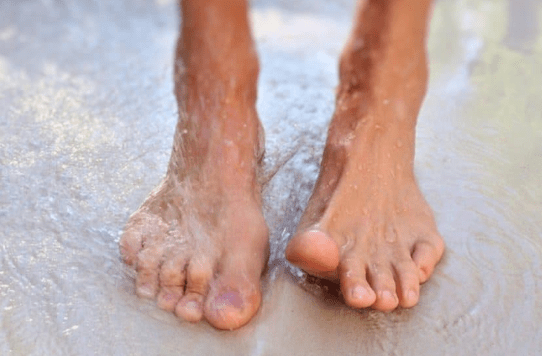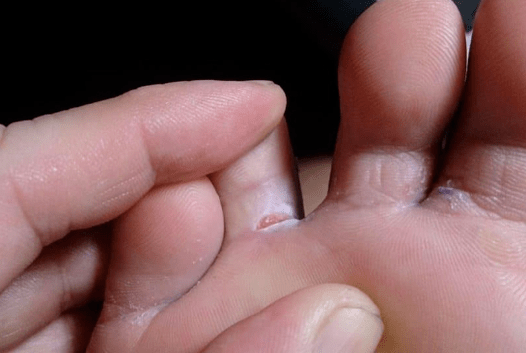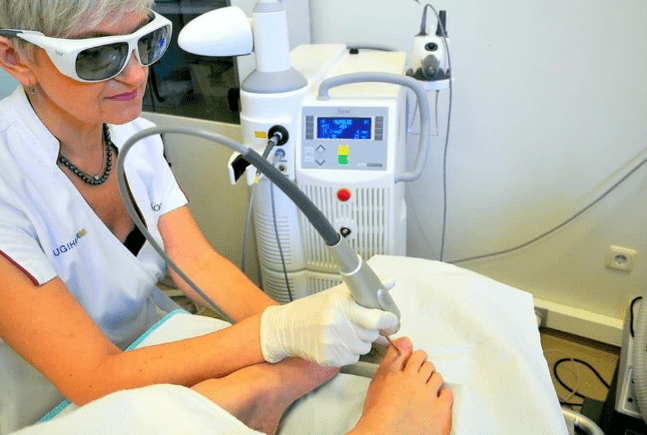This is the common name of infectious diseases that affect a person's feet, nailing on the legs or arms.In medicine, such diseases are called Mycose - a group of diseases stimulated by micro mushrooms.
Onychomycosis is distinguished - damage to nails and dermatological diseases - located on the skin of the leg.The disease is usually an independent disorder, as a rule, it develops based on the disorders of different genesis.What fungus looks like, the positioning of the type of pathogens depends.

However, there are a large number of mushrooms, only a few of them cause human pathological changes.The micosis of the foot accounts for the ratio of the second place of all skin diseases.The following mushroom groups are distinguished, very dangerous for health:
- Anthropophilic.I just provoke pathology in humans, you may be infected from others.
- Zooanthropophilic.They can also cause diseases in animals, infections from animals and others.
- Candidates.A separate mushroom, has its own characteristics.
There are several types of pathology with similar signs, which include rubbromicosis and epithelium.They are combined according to the general definition of Mik Mikoza Stop.The symptoms of the fungus are divided depending on the type, but often they grow in parallel, so this difference is conditional.The following forms of pathology are distinguished:
- scaly;
- Interiginosny;
- Dyshidrotic;
- Onychomycosis, divided into: Normotrophic, atrophy, hypertrophy.
The scientific name of the disease is onychomycosis.Infections affect the skin, mainly in the lower limbs, nails.Yeast and mold falling on an unprotected surface.
Chan fungus is a fairly common disease that is transmitted by the overall use of the objects.It is worth noting that its distribution occurs extremely quickly, while the development of the disease is concentrated in the area of the areas between fingers on the feet.
Reason
Infections are considered to occur with direct contact with fungi, the reproduction occurs extremely quickly in the environment of warm and moist surfaces of the skin.It can be infected with the fungus of the foot as a result of the contact created with the human skin with its mushrooms.
The situations in which mushroom transmission is done by tools used to manicure and toenails, as well as through shoes and towels, no exception.
Typically, the feet damage occurs in people with problems with excessive weight and circulation in the bloodstream, and people with deformation of the foot often suffer.Violation in the immune system, caused by an unhealthy lifestyle, stress, antibiotic use in antibiotic treatment, as well as malnutrition, also determine the possibility of fungal infection.
Wet skin, cracks, irritation on the feet, fungi causing disease and conditions that cause disease and conditional disease.The following mushrooms:
- The fungus causes disease when it enters the skin, leading to the growth of inflammation, a fungal disease occurs;
- The pathogenic microorganisms are continuous on the skin, and the increased activity is only manifested with the impact of stimulating factors.
The source of infection is people with Mycosis.The pathogenic flora enters healthy skin in places where people accumulate.Comfortable mushrooms grow in high heat and humidity.
Where infection:
- pool;
- bathroom;
- dressing rooms in sports centers;
- public bath;
- sauna;
- Fitness center.

Important!Never walk barefoot in common areas.For classes at a sports club, swimming pool, when you go to the sauna, wear special shoes with you.
Some industries are at risk.The reason is that a long time of the feet in a discreet, warm, wet environment.Mushroom skin lesions are often affected:
- exploitation;
- athletes;
- army;
- Hot store workers.
Pay attention!Mycoses often develop in people who are obliged to wear closed shoes, whether they are comfortable with their feet or not.Describe the job for many industries to prescribe shoes as a special unit even in the hot season.It is difficult to fight Mycosis in such conditions.
Other causes of fungal diseases:
- Bad hygiene of legs;
- Skin injury;
- immunosuppressive;
- Suitable shoes without a nylon sock;
- Complications for diabetes.
Types and symptoms of foot fungus
There are many types of mushrooms.
Foot skin often affects the following types:

- Red Trichophyte damages the foot and heel;
- Trichophyte technical is distributed to the area between times, and in advanced cases affect the feet, skin of the thumb and the epidermis on the small fingers;
- Trichophyte mentagrophytes - a type of fungal infection developed in the human body (armpits, groin folds);
- Candida fungus - infections that cause candid fungus of mucous membranes and genitals, but there are also skin lesions.
Dermatophyte can cause local damage.The name of a disease of epithelium is a very infectious disease, thriving in the human body.
There are three forms of foot mushrooms:
- Dermatophytosis Interdalz is in acute and chronic form;
- Mochacino-sicut;
- Vesicular, ulcer.
The general symptoms of the disease are itching and severe burns, stimulating skin, then peeling of particles.Those are the common signs that can be seen in the internet image that the Internet is full.
Interdalz dermatophytosis
What is this form?Most common, mainly located between the fourth and 5th finger of the feet.It occurs in the form of cracks: with a wet form, the skin looks swollen, and with a dry piece, it flakes and falls out.
Typically, along with dermatologists Interdald-Fitia, other bacterial infections stand out in the foot.Advanced form begins.The symptoms are enhanced, uncomfortable feeling - too, the patient feels serious pain, cannot escape.
The initial stage of the technical shape of the mushroom.
If the skin is cracked, blood can act, causing more suffering.Psychological factors appear - Some people are trying to independently tear the peeling particles of the skin, and this is not recommended to do this, because of the new infection.The disease is worse.
The common name "foot athletes" is about the shape of the mushroom on the foot.It is quite difficult, causing treatment, but most recognizable.With this pathology, the nails are affected, starting to change color to black, green, blue or yellow.The transparency is lost, the nails are gradually deformed, poured and shattered.
At that time, the feet were peeling, covered with scales on both sides.The leg becomes like a moccasin.
A rare form of the disease, when compared to Interdaltsevo and Mochacino-Sicut.Blister blisters with mud liquid are manifested on the entire surface of the foot.Over time, they were ripe and broken.
The photo was presented with the shape of the foot fungus
The additional signs of additional attention in patients are:
- Itching and burning continuously;
- Powder, skin lying;
- Fingerertips, also contaminated with a fungus that is exposed to infected parts of the body;
- leg swelling;
- Sometimes the body temperature increases greatly.
Causes of disease development
The origin of the disease is a person with a fungus, with skin particles still on objects or in public places.It could be a bathroom, swimming pool, dressing room and shower.Onychomycosis feels great with high humidity and stable at low temperatures.
Usually, the cause of the development of the disease is:

- Antisanitaria in beauty shops, when the toenail tools do not handle or do it badly;
- The use of other people - towels, towels, combs;
- Hygiene is not enough, increasing leg sweat.
Not completed with hygiene or excessive sweating of the legs leads to the mushrooms of the foot
But one connection to microbiological Exciter is not enough.There are additional risk factors that worsen the situation and enhance, accelerate the development of the disease.
They include:
- Traumatic foot and nails, because when infected, the disease usually turns to the skin;
- Reduce immunity.As soon as this happens, microorganisms begin to attack with revenge, eliminating them is much more difficult;
- HIV infection;
- Bad habits - alcoholism, smoking, overeating;
- Cardiovascular disease, diabetes;
- Lymphostocation of the lower limbs.
Stages and their manifestations
The failure of the legs with the microorganisms of the pathogenic flora has some stages or forms of clinical development on the skin:
- repeat period or initial stage;
- Digital inter -infections;
- Squamous-hyperkeratotic shape;
- Dyeing phase (wet mushroom).
Folk remedies to treat mushrooms
Folk treatments can only be used as auxiliary agents.As the main treatment of mushrooms, folk remedies are ineffective, but can enhance the treatment effect of the drug.
First of all, the bathroom is used.They have anti -fungal and steaming effects, improve the penetration of the ingredients of the ointment and the mushroom solution into the deep layers of the epidermis.The bathroom can be done according to the following formulas.
- Add 4 tablespoons of vinegar to the basin with water and steam for 15 minutes.
- Take two tablespoons of salt, soda and iodine for 4 liters of water.
- Add boric acid powder to the bath with a speed of 10 g over 2 liters of water.
- Dissolve four tablespoons Tar soap in a basin with hot water, half a soda.
- Add 100 g of soda and juice of a lemon to a bath with water.Fresh juice can be replaced with 10 drops of lemon essential oil.
The bathroom must be performed daily throughout the treatment time.They are recommended to be used before applying an antifungal.With foot mushrooms, you can use creams.The alcohol of propolis helps to accelerate recovery.It must be mixed with water, and then moisturize a cotton swab in the solution and treat the skin of the leg.
So far, there are many recipes for traditional medicine, its effectiveness is largely inferior to some drugs.It is worth noting that a positive result of replacement therapy can only be observed at the initial stage of the growth of fungal infections.The advanced form of mycosis of stops is not due to traditional medicine.
The drugs of traditional medicine, like different drugs, can be useless in the treatment of fungi on the legs.But, in this way, its effect has been proven for centuries.
Tea tree essential oil is the best remedy that does not endanger the general health condition.Therefore, it can be used safely in pediatric.Due to the presence of disinfectant effect, the growth of pathogenic fungus is blocked under its effects.
To prepare ointment, mix aloe vera gel and tea tree oil in a ratio of 1: 3. This tool is brushed into the affected areas twice a day.Such operations are recommended to be performed daily for three months.



























